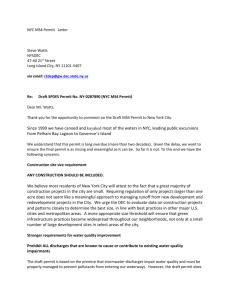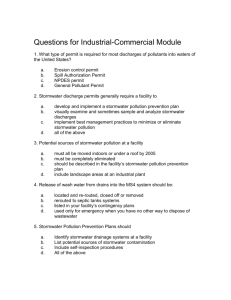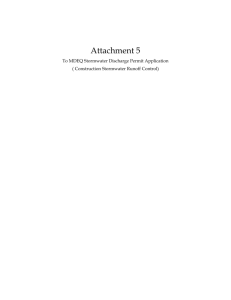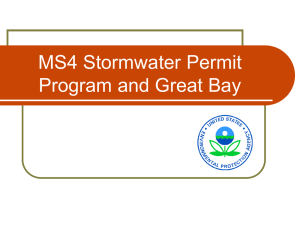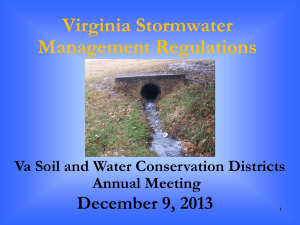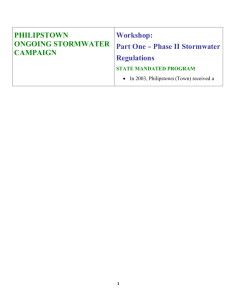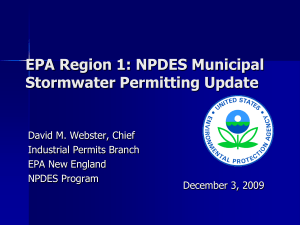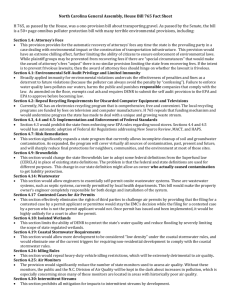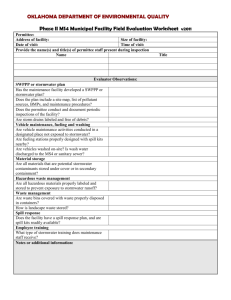Summary of Current and Proposed MS4 Permits
advertisement
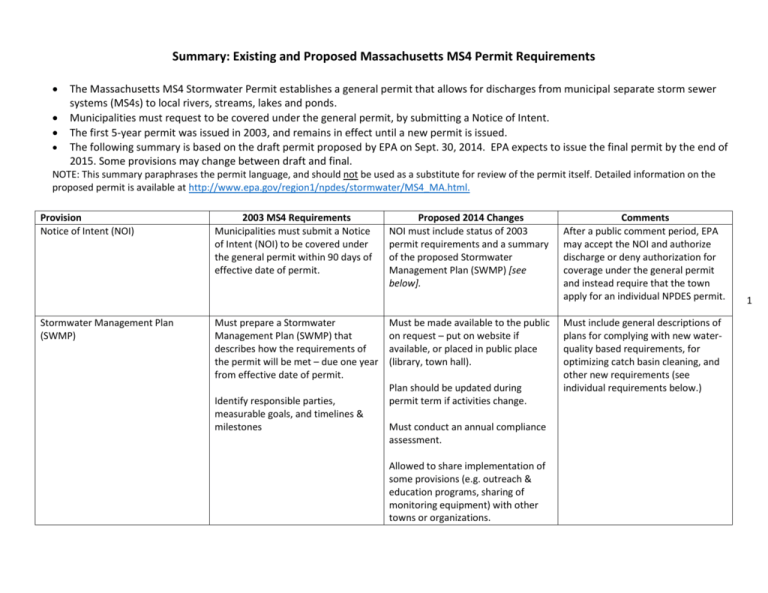
Summary: Existing and Proposed Massachusetts MS4 Permit Requirements The Massachusetts MS4 Stormwater Permit establishes a general permit that allows for discharges from municipal separate storm sewer systems (MS4s) to local rivers, streams, lakes and ponds. Municipalities must request to be covered under the general permit, by submitting a Notice of Intent. The first 5-year permit was issued in 2003, and remains in effect until a new permit is issued. The following summary is based on the draft permit proposed by EPA on Sept. 30, 2014. EPA expects to issue the final permit by the end of 2015. Some provisions may change between draft and final. NOTE: This summary paraphrases the permit language, and should not be used as a substitute for review of the permit itself. Detailed information on the proposed permit is available at http://www.epa.gov/region1/npdes/stormwater/MS4_MA.html. Provision Notice of Intent (NOI) Stormwater Management Plan (SWMP) 2003 MS4 Requirements Municipalities must submit a Notice of Intent (NOI) to be covered under the general permit within 90 days of effective date of permit. Must prepare a Stormwater Management Plan (SWMP) that describes how the requirements of the permit will be met – due one year from effective date of permit. Identify responsible parties, measurable goals, and timelines & milestones Proposed 2014 Changes NOI must include status of 2003 permit requirements and a summary of the proposed Stormwater Management Plan (SWMP) [see below]. Must be made available to the public on request – put on website if available, or placed in public place (library, town hall). Plan should be updated during permit term if activities change. Must conduct an annual compliance assessment. Allowed to share implementation of some provisions (e.g. outreach & education programs, sharing of monitoring equipment) with other towns or organizations. Comments After a public comment period, EPA may accept the NOI and authorize discharge or deny authorization for coverage under the general permit and instead require that the town apply for an individual NPDES permit. Must include general descriptions of plans for complying with new waterquality based requirements, for optimizing catch basin cleaning, and other new requirements (see individual requirements below.) 1 Provision Water Quality-Based Limitations (for MS4s that discharge to listed impaired waters or waters with exceedances of water quality standards for stormwater-related pollutants) 2003 MS4 Requirements Proposed 2014 Changes New requirements for MS4s that discharge to rivers, streams, lakes or ponds that do not currently meet the Mass. Water Quality Standards (i.e. that are listed by the state as “impaired” or that, although not listed, are experiencing levels of pollutants above the standards.) Requirements vary by the pollutant causing the impairment and by whether or not a TMDL has been issued (see below). With a TMDL Determine if a TMDL is applicable. Assess and document whether TMDL provisions are being met, and describe in SWMP and Annual Reports measures to control the targeted pollutant, with implementation schedules. Must develop and implement plans to meet the Waste Load Allocations (WLAs) established by approved TMDLs. Comments Applies only to pollutants that are known to be found in stormwater: nutrients (nitrogen & phosphorus, bacteria/ pathogens, chloride, solids (TSS), oil & grease (hydrocarbons), and metals. See attachment for selected list of the impaired waters potentially affected by Belmont, Arlington and Watertown. A “Total Maximum Daily Load” (TMDL) is a rule for a particular water body and pollutant that establishes requirements for reducing the amount of the pollutant discharged, based on the maximum “pollutant loading” that will comply with the water-quality standards. TMDLs have been issued for some but not all impaired waters in Mass. May require percent reductions for specific sources of the pollutant, or specific required activities that are expected to reduce loadings. See attachment for requirements by pollutant (from Appendix F of permit). 2 Provision Without a TMDL Six Minimum Control Measures (MCMs) Public Education & Outreach 2003 MS4 Requirements Determine whether MS4 discharges contribute directly or indirectly to impairments. Proposed 2014 Changes Must identify BMPs to comply with requirements specific to each pollutant. Comments See attachment for requirements by pollutant (from Appendix H of permit). Describe in SWMP measures to control the targeted pollutant. Define measurable interim and final goals for each control measure. “BMPs” = Best Management Practices – a general term for a variety of structures or activities designed to reduce the quantity of stormwater discharges, prevent erosion or reduce the pollutants in stormwater discharges. The 2003 permit established 6 categories of requirements: Public Education & Outreach Public Involvement & Participation Illicit Discharge Detection & Elimination (IDDE) Construction Site Runoff Control Post-Construction Stormwater Management Good Housekeeping Develop educational program & distribute educational materials to the community. Demonstrate progress toward longterm goals of the control measures (qualitative or quantitative). An iterative approach. (Not required to completely address by end of permit term.) Retains the same 6 categories, but in many cases requires additional activities, more reporting, and/or specific deadlines. See below. 3 Requires 2 targeted messages for each of 4 specific audiences (residential, business/commercial, developer/construction, and industrial) during the permit term. Requires evaluation of effectiveness before 2nd message for each target audience, showing progress toward defined goals. EPA will provide templates and educational materials. Provision Public Involvement & Participation 2003 MS4 Requirements Provide opportunities for the public to participate in review and implementation of the SWMP. Proposed 2014 Changes Education should also address pollutants of concern for impaired waters and TMDL waters. Comments Requires opportunities for the public to participate in review and implementation of the SWMP. Comply with state public notice requirements. Illicit Discharge Detection & Elimination (IDDE) Develop, implement & enforce a program to detect & eliminate illicit discharges. (EPA provided guidance for elements of an IDDE program.) Develop map showing location of outfalls & receiving waters. Prohibit non-stormwater discharges into the MS4. Inform employees, businesses & general public re hazards of illicit discharges & improper waste disposal. Must eliminate any illicit discharges as quickly as possible. If elimination within 60 days is not possible, requires a schedule for elimination, immediate start to actions, and efforts to minimize pollutant discharges. Must develop an inventory of known Sanitary Sewer Overflows (SSOs) within the last 5 years, by 60 days of permit effective date; requires written report of SSOs to EPA when detected. Inventory outfalls and interconnections, and update annually. Include date of most recent inspection, materials and design, physical condition, results of most recent inspection. Additional system mapping requirements: Must include locations of catch basins, manholes, pipes (storm drains & sanitary sewers), interconnections with other “Illicit discharges” = any discharge to the MS4 that is not entirely stormwater, except when regulated under a permit or water used for firefighting. MS4s may allow any of a specific list of other non-stormwater discharges (e.g. water line flushing or lawn watering) unless they are significant contributors of pollutants to the MS4. Illicits might result, for example, from illegal connections to the storm drain system (e.g. via connection of floor drains to the system), failing septic systems, illegal dumping practices, or the improper disposal of sewage from boating or camping. “Sanitary Sewer Overflows” (SSOs) are any discharges of untreated wastewater from a municipal sanitary sewer. May be caused by stormwater getting into sewers (inflow) and causing backups or overflows, by sewer line pipe breaks or blockages (by grease and solid debris or tree roots), or by 4 Provision 2003 MS4 Requirements Proposed 2014 Changes MS4s, treatment facilities (BMPs), and certain sensitive water resource areas; catchment (drainage area) boundaries; and receiving water impairments. Encourage including other elements: e.g. pipe materials, ages & sizes, and results of previous investigations; seasonal high water levels & topography; land uses and amount of impervious area. Preference for GIS mapping Develop a written IDDE program, including specific provisions: Description of responsibilities for implementing the program. Assessment & priority ranking of catchments (see below). Outfall & interconnection monitoring (see below). Catchment investigation procedures (see below). Removal of illicits or SSOs, with details in Annual Report, confirmation by sampling within one year after removal, and follow-up screening. Comments malfunction of pumping stations or power outages. Proposed permit requires specific elements of the IDDE program and detailed procedures, rather than relying on guidance. 5 Provision 2003 MS4 Requirements Proposed 2014 Changes Measures to prevent illicit discharges and SSOs, such as spill response & prevention, public awareness, hotlines, and training of public employees. Comments Indicators to evaluate effectiveness of the program, with Annual Reporting. Catchment assessment and ranking: Assess and classify each catchment as “excluded”, “problem”, “high priority” or “low priority”, based on specified criteria. Within each category, priority rank catchments based on specified screening factors. Complete within 1 year of permit effective date, and update annually. 6 Outfall monitoring: Written procedure for outfall and interconnection screening & sampling, including baseline (dry weather), confirmatory (dry or wet weather) and follow-up (dry or wet weather) screening. Includes detailed required sampling procedures and lists minimum sampling parameters. Catchment investigation: Ultimately (with 10 years) requires investigation of every catchment, whether or not outfall monitoring indicates a problem, with interim deadlines for different priority categories. Requires written procedures for review of mapping & historic records; manhole Proposed permit allows more flexibility in how pipe systems are investigated (e.g. either “top down” or “bottom up” in the system). “Junction manholes” have inlets with flow from 2 or more MS4 sources – a location to track possible pollutant Provision Construction Site Runoff Control 2003 MS4 Requirements Develop, implement & enforce program to reduce pollutants from construction projects disturbing one acre or more. Develop bylaw/ordinance requiring sediment and erosion control, and control of wastes (building materials, truck wash-out, chemicals, litter, sanitary waste). Post-Construction Stormwater Management Retitled in 2014 proposal: Stormwater Management In New Development and Redevelopment Provide for site plan and preconstruction review & receipt of information from the public. Develop, implement & enforce a program to address runoff from new development or redevelopment projects that disturb one acre or more. Develop bylaw/ordinance that requires controls on runoff, prevents or minimizes impacts on water quality, and ensures long-term operation & maintenance of practices. Proposed 2014 Changes inspection methods (focusing on key junction manholes); and procedures to isolate & confirm sources of illicit discharges. Must document System Vulnerability Factors for each catchment, with Annual Reporting. Comments flows from different locations upstream in the system. “Key junction manholes” are chosen to allow the most effective assessment of upstream illicit discharges. Includes specific interim and final deadlines for each component of the IDDE program. Requires written procedures to identify who is responsible for enforcement and that sanctions be imposed to the extent authorized by law. BMPs to be implemented may reference state standards or standards established by the municipality. Ordinances must incorporate a new performance standard –requiring retention onsite of first 1” of rainfall from all impervious area, or – if not feasible - equivalent treatment of the same runoff volume. 7 Stormwater Ordinances/Bylaws: No additional time allowed for issuing ordinances required by 2003 permit. Have 2 years to revise existing ordinances/bylaws to incorporate new requirements. EPA will provide guidance on how to handle the new performance standards for sites with constraints on infiltration (e.g. contaminated sites). Provision 2003 MS4 Requirements Proposed 2014 Changes Requires assessment of local nonstormwater ordinances/bylaws, regulations, and guidelines: 1. to determine if street design and parking lot guidelines can be changed to support low impact development (within 2 years); 2. to determine the feasibility of allowing green infrastructure practices (within 3 yrs.). Comments There is no deadline for actually addressing any barriers identified. Track IA and DCIA: estimate the number of acres of Impervious Area (IA) and of Directly-Connected Impervious Area (DCIA) added or removed in the previous year, due to development, redevelopment, municipal retrofits and private retrofits -- starting in yr. 2 Annual Report. EPA will provide baseline estimate of total IA and DCIA for each municipality. MS4 can propose alternative baseline estimates. Ordinances/bylaws must require submission of as-built plans within 90 days of completion of construction. Inventory and priority rank MS4owned property and infrastructure that could be modified or retrofitted to reduce impervious area, within 4 years of permit effective date. Report on retrofitting or modifications starting with Yr. 5 Annual Report. “Impervious Area” = land covered by buildings, roads, sidewalks, parking lots, driveways and other structures or paving that prevents stormwater from infiltrating into the soil. “Directly-Connected Impervious Area” = Impervious Area that drains to the storm drains rather than to a pervious area that allows infiltration (e.g. lawn or rain garden). Permit lists considerations that MS4s should use to determine the potential for retrofitting properties. 8 Provision Good Housekeeping & Pollution Prevention 2003 MS4 Requirements Develop and implement program to prevent or reduce pollutant runoff from municipal operations. Proposed 2014 Changes Develop an inventory of all municipal facilities and inventory of all floor drains (within 6 mos.; update annually) Comments Train employees about stormwater. Develop & implement maintenance activities and schedules for parks & open space, vehicle fleets, buildings, new construction and land disturbance, road drainage and stormwater systems. Develop inspection procedures & schedules for long term structural controls. Develop written operations & maintenance plans for municipal facilities by end of year 1 – including procedures for parks and open space (fertilizers & pesticides, lawn maintenance & landscaping, pet waste, trash disposal); buildings and facilities, including schools (storage & material use, waste management, employee training, sweeping, spill prevention plans), and vehicles & equipment (storage, repairs & refueling). 9 Develop written program for maintaining MS4 infrastructure in a timely manner, within 1 yr. of permit effective date. Optimize catch basin cleaning requirements -- inspections, cleaning and repair when 50% full. Must track quantities removed from catch basins by catchment area, and report activities annually. Establish procedures for sweeping streets, sidewalks and municipal parking lots within 6 months; minimum municipal street and parking lot sweeping 1x/year in spring – with more frequent Provision 2003 MS4 Requirements Proposed 2014 Changes sweeping in targeted areas based on potential pollution load reduction. Comments Develop requirements for winter road maintenance: salt storage and usage and snow disposal. Develop inspection procedures for municipal stormwater controls (storm drains and all structural BMPs – annual inspection at minimum). Develop and implement a written Stormwater Pollution Prevention Plan (SWPPP) for each MS4-owned & operated maintenance garage, public works yard, transfer station, and other waste handling facility where pollutants are exposed to stormwater. Include a pollution prevention team, identify stormwater controls, and require specific management practices for minimizing exposures of materials to stormwater, good housekeeping, preventative maintenance, spill prevention & response, erosion & sediment control, management of runoff, covering of salt piles (within 2 years) and regular employee training (annual training recommended.) Conduct and document site inspections for areas exposed to stormwater at least quarterly, and correct defects prior to the next storm. Report on inspections annually. 10 Provision Program Evaluation Outfall Monitoring 2003 MS4 Requirements Proposed 2014 Changes Conduct annual self-evaluation of compliance with permit. Evaluate BMP appropriateness for achieving measureable goals, and change BMPs (with written explanation in Annual Report) as needed to achieve goals. Comments Monitor and sample at outfalls as required by IDDE screening (see above). Additional monitoring may be required to assess SWMP effectiveness, to evaluate discharges to water quality-limited streams, or to assess BMP effectiveness. Document all monitoring results in Annual Reports, including location & weather conditions. Include description of monitoring results provided by other parties. Prepared by Nancy Hammett Nhammett4@gmail.com September 10, 2015 Disclaimer: The preparer accepts no liability for any omissions or inaccuracies, but welcomes comments. 11 Attachment 1: Selected Impaired Waters Potentially Affected by Belmont, Arlington and Watertown SW Discharges [Based on Final 2012 MA Integrated List: http://www.mass.gov/eea/docs/dep/water/resources/07v5/12list2.pdf] Waterbody Charles River Watershed Charles River (Needham to Watertown Dam) MA 72-07 “ “ Charles River (Watertown Dam to BU Bridge) MA 72-36 “ “ “ Laundry Brook (“unnamed tributary) MA7230 “ Impaired for: (includes stormwater pollutants only) TMDL # E. coli 32370 Nutrient/eutrophication biological indicators Phosphorus (total) E. coli 40317 40317 32371 Nutrient/eutrophication biological indicators Phosphorus (total) Oil and grease Enterococcus and E. coli 33826 33826 Phosphorus (total) No TMDL* x 32381 x Mystic River Watershed Alewife Brook MA71-04 Copper, E. coli, Foam/Flocs/Scum/Oil Slicks, Lead, Phosphorus x Mill Brook MA71-07 E. coli x Mystic River (Lower Mystic Lake to Amelia Arsenic, E. coli, Phosphorus x Earhart Dam) MA71-02 Spy Pond MA71040 Phosphorus x Winn Brook MA71-09 E. coli x * “Impaired waters” include Integrated List Categories 4b “Impairment Controlled by Alternative Pollution Control Requirements” and Category 5 “Waters requiring a TMDL” Prepared by Nancy Hammett Nhammett4@gmail.com September 10, 2015 Disclaimer: The preparer accepts no liability for any omissions or inaccuracies, but welcomes comments. 12 Attachment 2: Summary of Water Quality-Based Requirements for Stormwater-Related Pollutants (Applies to Water-Quality Limited Waters) Pollutant Phosphorus With TMDL (Appendix F) Charles River Phosphorus TMDL: Requires specific percent reductions in phosphorus loadings: % reductions required and area affected, excluding reductions for which MA DOT and DCR are responsible and after credit for reductions from IDDE program: Arlington: 54% (0.4 sq. mile) Belmont: 45% (1 sq. mile) Watertown: 53% (4 sq. miles) Without TMDL (Appendix H) Prepare Source Identification and Assessment Report (submit with Yr. 4 Annual Report). List locations where structural BMPs can be installed on municipal properties, as retrofits or as part of redevelopment. Track phosphorus load reductions (methodology is defined). Additional MCM requirements: Must calculate annual changes in phosphorus loads – including increases due to new development and reductions due to depaving or disconnection. Cumulative % reduction targets are specified for years 8, 10, 13, 15, 18 & 20. Calculation methods specified for estimating phosphorus loads based on land use and portion of areas that are directlyconnected impervious area (DCIA) or pervious. Credits are available for enhanced street sweeping, catch basin cleaning, no application of fertilizer with phosphorus, and organic waste and leaf litter collection. Schedule: Years 1-5: Create Phase 1 Plan Legal analysis – yr. 2 Funding source assessment – yr. 3 Define baseline load and allowable loads (including alternative land use data, if appropriate) – yr. 4 Describe planning for nonstructural and structural controls (with O&M) – 5 yrs. Years 5-10: Implement Phase 1 Plan & Create Phase 2 Plan Full implementation of all non-structural controls – yr. 6 Performance evaluations – yrs. 6, 8, 9 & 10 Target public education on phosphorus sources and source reduction. For new development/redevelopment, require that BMPs be optimized for phosphorus removal. Target the collection of organic matter (leaf and yard waste collection.) 13 Pollutant With TMDL (Appendix F) Implementation of structural controls sufficient to achieve required reductions Years 10-15: Implement Phase 2 Plan & Create Phase 3 Plan (similar analysis, implementation, and performance requirements). Years 15-20: Implement Phase 3 Plan (similar analysis, implementation, and performance requirements). Charles River Pathogen TMDLs: No specific quantified reduction target. Compliance is based on the following enhanced SWMP components: Without TMDL (Appendix H) Bacteria/Pathogens Public outreach & education: Annual message to residents must encourage proper management of pet waste (permit specifies content of the educational materials). Educational messages must be disseminated to pet owners with issuance of a dog license (or other appropriate time). Additional MCM Requirements: Public outreach & education: Annual message to residents must encourage proper management of pet waste (permit specifies content of the educational materials). Illicit Discharge: Any catchments draining to waters impaired for bacteria/pathogens must be designated as either “Problem” or “High priority” in the IDDE program. In effect, this accelerates the deadlines for investigating these catchments. Illicit Discharge: Any catchments draining to waters impaired for bacteria/pathogens must be designated as either “Problem” or “High priority” in the IDDE program. In effect, this accelerates the deadlines for investigating these catchments. Chloride Develop a Salt Reduction Plan to reduce salt on municipal roads and facilities and on private facilities that discharge to MS4 (plan within 3 yrs., fully implement within 5 yrs.) For municipally-maintained facilities: Track types & amounts of salt applied and report in Annual Reports Planned activities shall include operational changes (prewetting, increased plowing prior to salting, etc.), new or modified equipment, training for staff or contractors, guidelines for application rates, regular calibration of equipment, no-salt or low-salt areas, & preventing exposure of salt piles. 14 Pollutant With TMDL (Appendix F) Without TMDL (Appendix H) Estimate am’t. of salt reduction expected for each activity. For private facilities: Solids, Oil & Grease (hydrocarbons), or Metals Establish ordinance/bylaw or other regulation preventing exposure of salt piles to stormwater at commercial & industrial sites. Provide annual message to private salt applicators & commercial & industrial site owners on proper storage & application rates. For new development and redevelopment, establish requirements to minimize salt usage and require use of alternatives where necessary. May submit written information demonstrating that discharges do not contain chloride in lieu of these requirements. For new development & redevelopment: Incorporate designs that allow shutdown & containment in emergencies. Require treatment equivalent to biofiltration prior to infiltration, for infiltration systems on commercial or industrial sites (encouraged). For MS4 good housekeeping/pollution prevention: Increase street sweeping frequency on municipal streets & parking lots for areas with potential for high pollutant loads. Prioritize inspection and maintenance of catch basins & clean more frequently if excessive sediment or debris is found. May submit written information demonstrating that discharges do not contain the targeted pollutant, in lieu of these requirements. Prepared by Nancy Hammett Nhammett4@gmail.com September 10, 2015 Disclaimer: The preparer accepts no liability for any omissions or inaccuracies, but welcomes comments. 15
